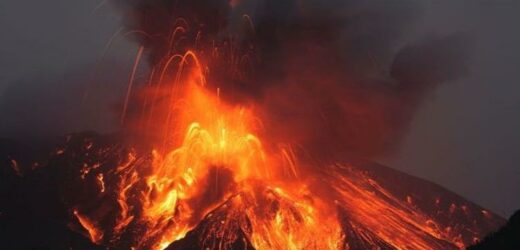Volcanoes are ‘huge trouble’ for Earth says Petranek in 2014
We use your sign-up to provide content in ways you’ve consented to and to improve our understanding of you. This may include adverts from us and 3rd parties based on our understanding. You can unsubscribe at any time. More info
Everyone has heard of the Yellowstone volcano and Mount Pinatubo – monstrous supervolcanoes that could trigger a nuclear winter of sorts if they ever erupted. But according to a team of volcanologists at the University of Cambridge, we should instead be paying attention to the potential fallout of much smaller eruptions. Researchers at the Centre for the Study of Existential Risk (CSER) at Cambridge have identified a series of seven “pinch points” where small but active volcanoes are clustered together near important economic hubs, industry infrastructure and trade routes.
These volcanic clusters are located in places like Taiwan, North Africa, North Atlantic and the Northwestern US.
Should any of these clusters erupt, the consequences could spiral out of control into a devastating domino effect.
The worrying findings were published today in the journal Nature Communications.
The study’s lead author, Dr Lara Mani from CSER, said: “Even a minor eruption in one of the areas we identify could erupt enough ash or generate large enough tremors to disrupt networks that are central to global supply chains and financial systems.


“At the moment, calculations are too skewed towards giant explosions or nightmare scenarios, when the more likely risks come from moderate events that disable major international communications, trade networks or transport hubs.
“This is true of earthquakes and extreme weather as well as a volcanic eruption.”
Volcanic eruptions are ranked on the so-called Volcanic Explosivity Index or VEI.
Since the Eighties, scientists have been using the chart to describe the strength and intensity of volcanic eruptions, based on the amount of material released.
Any volcano that has had an eruption of VEI 8 or above is considered a supervolcano.
Yellowstone Volcano: Super eruptions 'are very rare' says expert
According to the US Geological Survey (USGS), VEI 8 represents “mega-colossal explosive eruptions” that release more than 240 cubic miles (1,000 cubic km) of material.
By some estimates, a major Yellowstone eruption today could “immediately” kill 90,000 people and blot out the skies with ash.
But these are very rare events and there is no reason to believe a supereruption is going to go off within our lifetime.
The Cambridge researchers have instead argued eruptions up to VEI 6 could be just as catastrophic.
The eruptions could disrupt crop yields and cause food shortages, damage or destroy undersea internet cables, or even have an impact on the financial markets.


The world got a taste of the potential chaos in 2010 with the eruption of Iceland’s Eyjafjallajökull volcano.
Identified near a European “pinch point”, the volcano grounded aircraft all over the continent and left the global economy reeling with a £3.59billion ($5billion) loss.
Another “pinch point” includes a cluster of volcanoes on the northern tip of Taiwan.
As one of the world’s biggest producers of electronic goods, an eruption in the region could bring the global tech sector to a halt.
Another “pinch point” has been identified in the Mediterranean, where the eruptions of Vesuvius and Santorini could economically cripple the whole region.
Dr Mani said: “We saw what a six-day closure to the Suez Canal did earlier this year, when a single stuck container ship cost up to ten billion dollars a week in global trade.”
Other “pinch points” have been identified in the US, the Indonesian archipelago and the South China Sea – major sources of global trade and business.
Dr Mani added: “It’s time to change how we view extreme volcanic risk.
“We need to move away from thinking in terms of colossal eruptions destroying the world, as portrayed in Hollywood films.
“The more probable scenarios involve lower-magnitude eruptions interacting with our societal vulnerabilities and cascading us towards catastrophe.”
Source: Read Full Article


